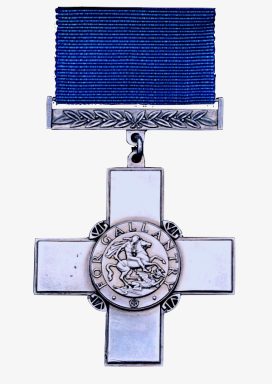Oxfordshire Gallantry Board to commemorate the county’s military and civilian heroes




Soldiers of Oxfordshire Museum (SOFO) have announced a new exhibition called Oxfordshire Gallantry Board. The following is taken from their news release.
On 22 October 2023 Soldiers of Oxfordshire Museum (SOFO) in Woodstock will unveil a new display to celebrate some of the county’s most remarkable heroes – the 31 men who have been awarded the Victoria Cross, the George Cross, or the Edward and Albert medals that preceded its institution.
The county’s military museum aims to excite the curiosity of visitors through the diverse stories of the county and its people, and those told in the new display are among the most impactful.
SOFO Museum is most grateful to 6 county-based charities which have supported the new display, and the VC & GC Association which worked closely with museum on the content of the new exhibit. The museum would like to thank the Annabel Arbib Foundation, Barnsbury Charitable Trust, C L Lloyd Charitable Trust, Greening Lamborn, HDH Wills 1965 Charitable Trust, and Tom Hall Charitable Trust.
The Victoria Cross was instituted by the Queen in 1856 to recognise exceptional acts of valour in the presence of the enemy, and was open to all ranks of the military. Previously, acts like this would have only been recognised with a ‘Mention in Dispatches’ by a senior officer.
All those recognised on the museum’s board are individuals who have close and enduring links to Oxfordshire. Many were born in the county, or were residents for much of their life. Others served in one of the county regiments, or in one of the permanently-based Royal Air Force stations, such as Bicester or units like the EOD (Explosive Ordnance Disposal) regiment based in Didcot.
10 Oxfordshire men were awarded the VC prior to 1914, in campaigns ranging from the Crimean War to the Boer War. James Langley Dalton, assistant commissary in Lord Chelmsford’s force during the Zulu War, was one of the 11 men who were honoured with the award of the VC following the January 1879 action at Rorke’s Drift. Today, he gives his name to Dalton Barracks in Abingdon.
6 more VCs were awarded to county men during the Great War. Famously these include the double VC Noel Godfrey Chavasse of the Royal Army Medical Corps who was born in Oxford, lived in Banbury Road during his early life, and attended Magdalen College School. Both of Chavasse’s VCs were awarded for service in France, the second in 1917 posthumously. Also included are the VCs awarded to Edward Brooks and Alfred Wilcox, both serving on the Western Front in the same Territorial battalion of the Oxfordshire and Buckinghamshire Light Infantry.
The George Cross and the George Medal were both instituted in September 1940 by King George VI for “acts of the greatest heroism or of the most conspicuous courage in circumstances of the most extreme danger”. It would supersede the Empire Gallantry Medal, and by 1971, replace the Albert and Edward Medals. The Albert Medal was instituted in 1866, awarded for saving lives at sea, while the Edward Medal was instituted in 1907. Originally awarded solely for bravery amongst miners and quarrymen, it was extended to farm and industrial workers.
Dr Andrea Angel, an Oxford lecturer in chemistry, received a posthumous Edward Medal after he was tragically killed whilst supervising the evacuation of staff when the Brunner-Mond munitions factory in East London caught fire and exploded in January 1917.
The county’s Second World War Victoria Cross and George Cross recipients cover both civilian acts of bravery and all branches of the armed forces, with three GCs awarded to men in the Royal Navy. Henry James Miller, of Hanborough, died whilst helping to evacuate the crew from his submarine HMS Unity in April 1940 after a night collision with a freighter in the North Sea.
Lawrence Frank Sinclair, a Shipton-under-Wychwood resident, was awarded the GC in September 1940 for saving a severely injured airman from a crashed and burning aircraft.
Leonard Cheshire VC, of Oxford and Abingdon, earned his prestigious gallantry award whilst serving in Bomber Command. He became one of the most decorated officers in the RAF and founded Cheshire Homes after the war.
Robert Llewellyn Jephson Jones, of Oddington, was a Royal Army Ordnance Corps officer serving on the island of Malta, and was awarded for his part in defusing around 275 unexploded munitions over just 6 months in 1940.
Commissioned as an officer with the Oxf. & Bucks Light Infantry and attached to the Parachute Regiment at the time, John Hollington Grayburn was killed at Arnhem in September 1944, and posthumously awarded the VC. Every account indicates he was a brave and inspirational leader. Wounded multiple times, he refused evacuation, instead staying to lead his men.
Since the end of the war, five more GCs have been awarded to Oxfordshire men – four of these were based at different times at Vauxhall Barracks in Didcot, the home of the Army’s EOD regiment. The most recent of these were in 2009. Kim Spencer Hughes and, posthumously, Olaf Sean Schmid, both served with the Royal Logistic Corps in Helmand province, Afghanistan, where the threat of ambush by improvised explosive devices was ever present during the British army’s deployment there.
This new board in the SOFO museum tells of those Oxfordshire people whose valour on the battlefield, and gallantry in action were formally recognised by their awards – civilians and soldiers alike.





No Comments
Add a comment about this page